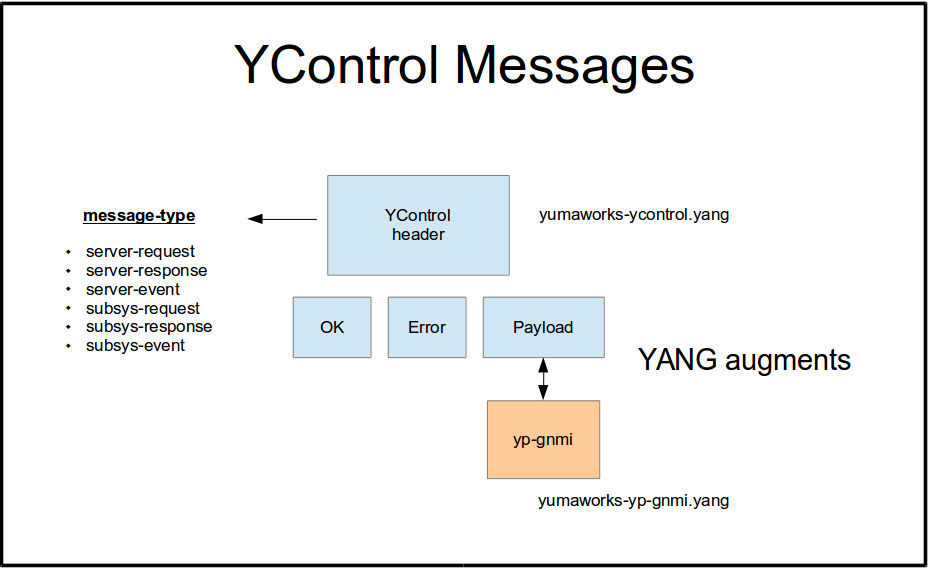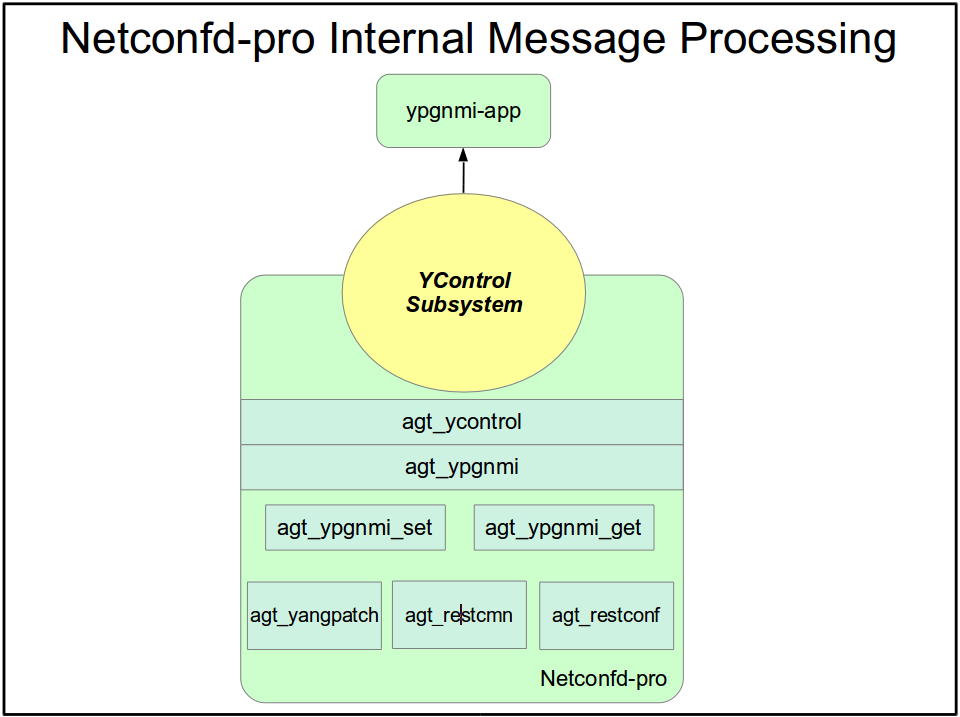ypgnmi-app Internals
ypgnmi-app Subsystem Overview
The ypgnmi-app subsystem provides connectivity between the netconfd-pro server and external gNMI clients. It serves as an intermediary layer that enables seamless communication between the YumaPro server infrastructure and OpenConfig-compliant telemetry clients.
This architecture enables bidirectional, real-time communication between gNMI clients and the YumaPro datastore using standardized protocols and data models.
The application continuously listens for communication from the netconfd-pro server and maintains an active AF_LOCAL or TCP socket connection.
At the same time, the ypgnmi-app functions as a gNMI server, handling client connections and requests over gRPC as defined in the gnmi.proto.
ypgnmi-app Initialization Processing
The ypgnmi-app application has the following startup steps:
Initialize all the pre-requisites and parse all the CLI parameters
Based on the netconfd-pro server modules capability create gNMI target
Open TCP socket to listen for gNMI clients requests
Open another socket and send <ncx-connect> request to the netconfd-pro server with
transport = netconf-aflocal
protocol = yp-gnmi
Register yp-gnmi service
Send <register-request> to the server
Register ypgnmi-app subsystem and initialize all corresponding code in the netconfd-pro server to be ready to handle ypgnmi-app application requests
Create a data model structure that will be used for gNMI client/server communication
Send <config-request> to the server
Feed the gNMI ModelData with all supported modules
Serve any incoming gNMI messages from gNMI clients and re-transmit them to the netconfd-pro server.
Message Processing Overview
The following diagram illustrates the message processing flow between gNMI clients, the ypgnmi-app application, the netconfd-pro server, and the internal datastore used for configuration and state retrieval.

The end-to-end message processing path from gNMI clients to the netconfd-pro server can be divided into the following stages:
gNMI Client -> ypgnmi-app - Handles incoming gNMI messages encoded in Protocol Buffers (protobuf) format and transmitted over gRPC. The ypgnmi-app parses, validates, and converts these protobuf-encoded messages into XML representations that are compatible with the netconfd-pro server's internal YControl communication format.
ypgnmi-app -> netconfd-pro - Performs bidirectional message exchange between the ypgnmi-app and the netconfd-pro server using YControl protocol messages encoded in XML.
Internal netconfd-pro Processing - Executes subsystem registration, message handling, and parsing within the server. The received XML requests are converted into internal RESTCONF control blocks for further processing:
YANG-PATCH - Used for handling gNMI SetRequest operations.
RESTCONF GET - Used for handling gNMI GetRequest and Subscribe operations.
ypgnmi-app Message Format
The ypgnmi-app application uses several messages to interact with the netconfd-pro server.
These messages are defined in the yumaworks-yp-gnmi.yang YANG module. The ypgnmi-app payload is defined as a YANG container that augments the YControl "message-payload" container.
The following diagram illustrates the YControl messages overview:

ypgnmi-app Registration Message Flow
During the startup phase, the server will initialize the yp-gnmi subsystem callback functions and handlers (similar way as for db-api module does).
The connection with the server is getting started with <ncx-connect> message that adds the YControl subsystem with the "yp-gnmi" subsystem ID to the server.
YControl protocol connection parameters:
transport:
netconf-aflocalprotocol:
yp-gnmi<port-num> not used
Additional parameters:
subsys-id:
yp-gnmi
The Registration message flow looks as follows:
ypgnmi-app to Server: config-request The service requests the netconfd-pro server its configuration in 1 message.
Server to ypgnmi-app: config-response The server responds to the config request with a list of modules that need to be loaded to gNMI server DataModel
ypgnmi-app to Server: register-request The ypgnmi-app service registers callbacks supported by the subsystem.
Server to ypgnmi-app: ok The server responds to the register request with an <ok> or an <error> message.
gNMI Request Processing
This section describes the internal processing flow of gNMI requests within the ypgnmi-app subsystem and their subsequent handling by the netconfd-pro server.
Together, these components provide complete end-to-end message processing for model-driven telemetry in YumaPro.
ypgnmi-app Processing
The ypgnmi-app subsystem employs multiple goroutines to manage client connections, message parsing, and response delivery. These concurrent routines ensure efficient, asynchronous communication between gNMI clients and the netconfd-pro server.
Goroutine Responsibilities:
Client Manager. Manages all active gNMI client connections. Upon receiving a connection request, this goroutine registers the client, maintains session information, performs certificate verification, and enforces authentication policies. It also initiates connection termination when validation fails or a session expires.
Reply Manager. Handles messages that have been parsed and are ready for processing. It maintains a queue of pending replies, matches them to corresponding client sessions, and initiates the appropriate response procedures.
Message Parser. Responsible for decoding and encoding messages. Incoming client messages encoded in Protocol Buffers (protobuf) over gRPC are parsed and converted into XML-encoded YControl messages destined for the netconfd-pro server. Conversely, responses from the server are converted from XML back into protobuf before being sent to the clients.
Message Manager. Coordinates all outbound and inbound message queues. It stores messages ready to be processed or forwarded, both to the netconfd-pro server and from the server back to the clients.
All of these managers operate as independent goroutines, running concurrently and asynchronously to maintain continuous, high-throughput communication.
ypgnmi-app gNMI Server Implementation
At its core, the ypgnmi-app implements a full gNMI server built on top of a gRPC server framework.
This implementation is responsible for handling all major gNMI service operations and maintaining secure communication channels with clients.
Core Responsibilities:
Facilitate gNMI client to netconfd-pro server communication.
Handle Get, Set, Subscribe, and Capabilities RPC callbacks.
Manage message exchange between gNMI clients and the netconfd-pro server.
Register and initialize the internal gNMI and gRPC servers for protobuf message handling.
Execute the main service loop that manages all incoming and outgoing communication.
The ypgnmi-app runs as an HTTP/2 server over TLS, implemented using the Go standard package golang.org/x/net/http2.
This package provides the complete set of authentication, connection management, and listener mechanisms required for secure and reliable operation.
netconfd-pro Request Processing for gNMI
The diagram below illustrates the internal request handling flow within the netconfd-pro server after receiving messages from the ypgnmi-app subsystem.

The message processing steps:
The server parses the received <ycontrol> message originating from the subsystem.
The message is dispatched to the corresponding YControl service handler registered for yp-gnmi.
The YControl yp-gnmi service callbacks process the incoming message according to its operation type.
The internal RESTCONF dispatcher is invoked to process the corresponding operation:
Dispatch RESTCONF GET request in case of gNMI GetRequest.
Dispatch YANG-PATCH processing in case of gNMI SetRequest.
The netconfd-pro server builds a response message based on the results returned by the RESTCONF dispatcher.
The completed response is sent back to the ypgnmi-app service via YControl, which then delivers it to the appropriate gNMI client.